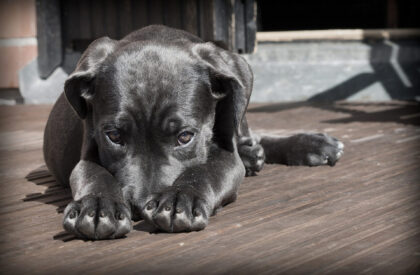 Fascinating mountains of muscle or potential danger? While on the one hand small dogs are in great demand, there are also more and more people who are warming to the complete opposite: the massive, well-muscled Molosser dog breeds have their very own circle of friends. A breed that is relatively new in this country is becoming increasingly popular: the Cane Corso italiano. Breeders and lovers in particular praise the Cane Corso as a friendly, calm family dog, but it is still considered a listed dog in several federal states. And the truth, as is usually the case, lies somewhere in between.
Fascinating mountains of muscle or potential danger? While on the one hand small dogs are in great demand, there are also more and more people who are warming to the complete opposite: the massive, well-muscled Molosser dog breeds have their very own circle of friends. A breed that is relatively new in this country is becoming increasingly popular: the Cane Corso italiano. Breeders and lovers in particular praise the Cane Corso as a friendly, calm family dog, but it is still considered a listed dog in several federal states. And the truth, as is usually the case, lies somewhere in between.
Brief history of the breed
The Cane Corso italiano probably goes back to the ancient Roman Molosser dogs, which are already depicted on ancient frescoes. The typical Cane Corso finally emerged in the south of Italy: for centuries they were kept as domestic and farm dogs and were also used as hunting, herding or herding dogs.
With increasing industrialization, the number of Corso dogs decreased more and more and they soon became extinct. At the end of the 20th century, committed breed lovers began to reunite the scattered populations and enable the ancient Italian dog breed to continue to exist. In 1996, the Cane Corso italiano was finally recognized as a separate breed.
Appearance of the Cane Corso
In its appearance, the Cane Corso is a typical Molosser: Muscular, with a robust build and a powerful skull, it makes a really impressive picture. When fully grown, the Coso dog reaches a shoulder height of up to 70cm and a weight of up to 50kg is not uncommon. Although it is massive, it is by no means clumsy. Instead, he impresses with good proportions and an athletic figure. Thanks to its centuries-long use as a versatile working dog, there are so far no cultivated anatomical exaggerations: its body structure and appearance are powerful, but always harmonious and natural.
As the breed is still relatively rare in Germany, many of the dogs used for breeding are imported from abroad and have their tails and ears docked accordingly – this gives the Cane Corso a particularly sharp appearance. However, since this practice has been banned in Germany for a long time, the Cane Corso with its innate floppy ears and long, slender tail will probably increasingly be adopted by German dog owners.
Characteristics of the Cane Corso
The Cane Corso is considered a friendly, even-tempered companion in all situations and is not easily disturbed by anything. However, despite his calm nature, this Molosser is not a lazy couch potato: Due to his history as a working dog, the Cane Corso still has a strong enthusiasm for work and demands appropriate activity.
Corso dogs are born with a strong instinct to protect and guard. If danger threatens, you protect your family and their property to the death, being fearless and uncompromising. However, a well-raised Cane Corso is not prone to unfounded aggression: in everyday life, he is rather calm and friendly – both towards his people and towards all the animals that belong to the household.
Between family and breed list
If you hear lovers of the breed rave about the calm, friendly nature of the Cane Corso, it is difficult to understand that these animals are considered listed dogs in Bavaria and Brandenburg. But as is often the case, it is primarily in the hands of the owner whether a Cane Corso puppy becomes an exemplary family dog or a dangerous muscleman.
The impressive appearance of this breed alone should make it clear to anyone interested that solid training work needs to be done here. Because once the massive bodies start moving, you won’t be stopped by a tug on the leash, but only by well-trained basic commands. 50 kilograms of dog can also cause people to fall and break bones while playing or greeting people happily. Therefore (as with most Molosser dogs) loving, consistent training must take place right from puppyhood. Since this is not necessarily easy, especially for dog beginners, it makes sense to bring in specialist staff who have experience with training Molossers. Then nothing stands in the way of a life as a friendly family dog.
Unfortunately, the reality is often different: like many other powerful dog breeds with impressive looksThe Cane Corso also attracts people with little expertise but a lot of aggression potential who want a “threatening” looking dog at their side to support their own ego. This development is currently still somewhat under control, as this still rare breed has hardly been bred in the wild and responsible breeders usually select their interested parties carefully. Nevertheless, the number of stud dogs offered “wild” and Cane Corso dogs given up because they were overwhelmed is already increasing. Since their massive physique actually becomes a potential danger if kept incorrectly, it makes sense to only be allowed to keep the Cane Corso under certain restrictions, such as a fenced property or proof of expertise – at least as long as these restrictions benefit species-appropriate and responsible husbandry come.
Image: © PaulShlyko / Fotolia.com

The content of the articles is for general information purposes only and does not replace diagnosis or treatment by a veterinarian. Reviews or testimonials are individual reports from verified customers. This information does not constitute medical advice and should not be understood as such.
Our daily inspiration comes from the special moments with our dogs. Here we share this enthusiasm and invite you to become part of the DOG FIT community on our social media channels.


Leave a Reply